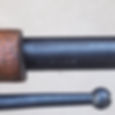
MANNLICHER MODEL 1895/30
Hungary
A BRIEF OVERALL HISTORY
The Mannlicher Model 1895 Rifle was adopted by the Austro-Hungarian Army in 1895. The Calvary Carbine and Short Rifle were adopted shortly thereafter. They were used through WWI and continued to see service in Austria, Hungary, and several countries post war, to include rear echelon use during WWII. Originally chambered in 8x50mmR, the vast majority were arsenal rebuilt and rechambered to the newer 8x56mmR in the 1930's. This rifle appears to have started life as a Model 1895 Short Rifle or Carbine.

MAKE AND MODEL
Marked on the top of the receiver is the make and model. This rifle was made in Budapest, Hungary by Fegyver és Gépgyár Rt, commonly abbreviated as F.G.G.Y. The model, M.95, does not differentiate between any of the variation of the rifle. Other features of the rifle must be used to identify long rifles, short rifles, and carbines.

R AND K
Since these rifles were produced by two different manufacturers, Österreichische Waffenfabriks-Gesellschaft (Steyr) and Fegyver és Gépgyár Rt (Budapest), many parts were marked by the manufacturers. Steyr used the letter "K" and Budapest used the letter "R". Here you can see the bolt of this rifle has been rebuilt with parts from both manufacturers.

FRONT SIGHT
The front sight mounted directly to the barrel, and not attached with a band, indicates this barrel was not cut down, as many were, and was originally a short rifle or carbine. This rifle has the tallest of 3 front sight variation. One explanation for this taller sight is for close range/police use.

REAR SIGHT
The rear sight is an original short rifle/carbine sight and was not changed when the rifle was re-chambered. It is graduated from 300 to 2400 schritt. This is an obsolete German unit of measure equal to about .75 meters and translates to "step". Notice the 4 separate sighting notches on the sight. The battle sight is set for 500 schritt.

PROOF MARKS
The two similar symbols, which are Austrian eagle crests, on the barrel shank and receiver are Austrian proof marks.

SERIAL NUMBER
The rifle serial number was originally marked on the barrel, receiver, and stock. The barrel and receiver are marked on the left side and have the same stamping style, indicating an original barrel. The stock is marked on the left side and does not match.

STOCK SERIAL NUMBER
The number on the stock is a serial number. It does not match the receiver/barrel and has a line through it. This is evidence of a replacement stock.

IMPERIAL ACCEPTANCE MARK
The original acceptance marks has been stamped over but appears to be "Wn [eagle] 15". This is the acceptance mark for the Imperial Army and indicates it was accepted in Wiener-Neustadt near Vienna. The number is the last two digits of the acceptance year, 1915. Only short rifles were produced after 1913, thus making this originally a short rifle or Stutzen.

CZECH ACCEPTANCE MARK
The "S[lion]11" stamped on top of and perpendicular to the Imperial acceptance mark is a Czech acceptance mark. Czechoslovakia was formed after the end of WW1 and received these rifles from 1919 to 1922. The number corresponds to a military district, 11 being Košice.

PROPERTY STAMP
On the right side of the receiver, near the Austrian proof mark, is a lion stamp. This appears to be a Czech lion stamp and is likely a property stamp.

RE-CHAMBERING MARK
The large "S" over the chamber indicates the rifle has been converted from the original 8x50R cartridge to the 8x56R M.30 S-Patrone cartridge. Czechoslovakia never converted their rifles to 8x56R. It is likely this rifle was surplused to Bulgaria where it was re-chambered.

STOCK MODIFICATIONS
The stock on this rifle appears to be a cut down rifle stock. The area between the two barrel bands is more roughly cut than the rest of the stock and there is a filled hole and line from where the rifle length rear rifle barrel band would have been.

STOCK REPAIR
This stock is cracked and has been repaired. I am not sure if this would have been done prior to or after the rifle was surplused. The crack is visible on the wrist but is most evident with the receiver and trigger group removed. The repair, a metal bracket perpendicular to the stock, can also be seen with the stock off the receiver.

IMPORT MARKING
There is an import mark on the bottom of the barrel just in front of the hand guard. The bottom of the text lines is very light, if there at all, but it can be identified as "AUSTRIANM95 8X56R", "CAI ST ALB VT". The first line is simply the model and caliber of firearms. The second line is the importer, Century Arms International, located in St Alban, Vermont. Century arms started importing firearms in the 1960's and moved from St. Albans in 2000, indicating the rifle was imported during that time frame.

CLIPS
The M95 uses an en bloc style clip that is retained in the magazine until the last round is chambered. At that point it is ejected out the bottom of the magazine. There are several variation of these clips with numerous manufacturers.









